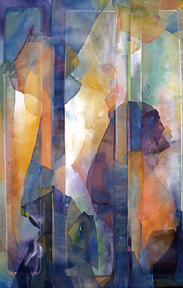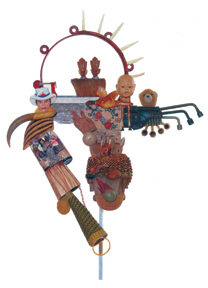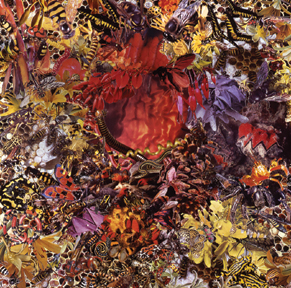

| For more information about this article or gallery, please call the gallery phone number listed in the last line of the article, "For more info..." |
February Issue 2004
Turchin Center for the Visual Arts in Boone, NC, Exhibit Offers Best of Assemblage & Collage
 Emily Richardson
Emily Richardson
In Boone, NC, The Turchin Center for the Visual Arts, which has enjoyed critical acclaim, strong community support and record crowds among art enthusiasts since its opening last May, will present its third exhibition, Sum of the Parts: Assemblage and Collage, from Feb. 6 through May 29, 2004. The unique collection by fourteen of today's most prominent artists, will be exhibited in the center's spectacular Martin and Doris Rosen Galleries.
Sum of the Parts explores the impact of collage and assemblage on American art. From the work of the early cubists, to the pop artists of the 1960s, to some of today's most interesting pieces, collage and assemblage serve both as design tools and methods to introduce concepts and contexts.
 David Brady
David Brady
Featured artists include: David Brady, Dale Copeland, Jennifer Davis, Suzi Gablik, John Garrett, Jerry Jackson, Janet Jones, Patricia Malarcher, Karl Mann, Emily Richardson, Joan Schulze, James Michael Starr and Pat Street, and Rick Horton (courtesy of Jerald Melberg Gallery, Charlotte, NC).
Notes Turchin Center director and chief curator Hank Foreman, "Collage and assemblage have been noticeably practiced since the early 20th century. Artists such as Arp, Braque, Hoch, Picasso, and other members of the avant-garde, dada, and surrealist movements often employed these techniques. Increasingly, collage and assemblage have seen a groundswell in contemporary art making."
"To me," continues Foreman, "these techniques are the perfect metaphor for the culture of our times. Boundaries are much less set in concrete than ever before. Artists move between media and often work in multimedia. All of us move between local, regional, national, and global citizenship with much greater ease; borrowing from cultural practices and lifestyles to create our own path. The very act of living today is often dynamic and continuously evolutionary. Collage and assemblage can speak to this state of affairs by either deconstructing and rearranging things in a way that expresses an overwhelming diversity, or by reconstructing things into new narratives."
Pat Street, one of the exhibition's featured artists, states, "I see collage as a metaphor for life. The fragments that make up a collage are similar to the images and moments that make up our daily lives- a glimpsed headline, a running dog, a burst of music, a child's smile, an orange leaf, a hug. Each element in a collage has a history and a context. No fragment is important by itself, but taken all together, they assume a significance that is greater than the sum of its parts."
 Karl Mann
Karl Mann
In describing the work of Karl Mann, The New York Times observes that "some collages from the early 1960s have a combination of raw physicality and formal elegance that calls to mind Robert Rauschenberg. But Mr. Mann has generally tended toward an unabashedly flagrant surrealism. Doll fragments, wallpaper, plastic animals, superhero toys, electric and mechanical parts, antique photographs, magazine advertisements: all this and much more to into the mix and arranged with an unerring design sense."
According to artist Dale Copeland, "People have been puzzled by the contrast: my optimism and enthusiasm for living seen against my work, which finds its beauty in images of fear, death and the follies of living. To me there is no contradiction: given the horrors, the brevity and the pain, an intense joy is the only rational response; dance till they drop you, exult while you can. Over all the joys of life, the fierce and inevitable decay. The objects I collect, the treasures I keep for years until they find their place, they may indeed be images of death, but for me their beauty is one of the great joys which make life into a glowing jewel in the dust."
James Michael Starr's collage and assemblage work is largely about appropriation. "I rarely if ever incorporate anything of my own creation into my work, acting instead as agent to combine scavenged elements I consider to be beautiful and which become even more so when they are brought together," says Starr. "Illustrations from old books, aged wood and strange but strangely familiar mechanical parts - all join in the wedding. The only exception, the only thing I feel I can add to the grace of these decaying objects, is a little of my own handwriting, something to prove that I was part of the ceremony."
 Suzi Gablik
Suzi Gablik
In describing the work
of Suzi Gablik, Greg Bryson writes, "Elements are juxtaposed
based on visual similarity alone. Lava echoes a waterfall; the
sunset visually matches burning trees. Plants and animals are
grouped by the patterning of their foliage, fur or feathers. Objects
metamorphose into other objects.
Everywhere patterns are related and repeated, an approach which
distinguishes her from the Surrealists, who emphasized the lack
of relatedness between the objects they collaged together."
Gablik says of her work, "Instead of thinking atomistically
in bits and fragments, I like things to be directed toward the
idea of making wholes, integrating systems, bringing elements
together and interweaving them into a whole system."
Joan Schulze's quilts have been described as "paintings experienced through fabric." Her numerous collections of found images, books about illuminated manuscripts, old and contemporary examples of text in many languages, calligraphy, and first drafts of her own poems combined with everyday experiences form the subject matter of her work. Early manuscripts written on parchment and vellum are of special interest to Schulze, and the process of scraping and reusing the material can be seen in her work.
John Garrett is a master magician of materials and techniques. His work might be woven, wrapped, plaited, riveted, painted, rusted, twined, nailed, stitched or tied. The materials could be nails, buttons, washers, corks, plastic flowers, painted aluminum, copper, cornhusks, bed springs, and even plastic curlers. Each work of art is a meticulously crafted, energetic and complex structure. He moves gracefully from construction wall pieces to baskets, breathing new life into discarded objects.
In connection with the Sum of the Parts exhibition, a series of other events is also scheduled, call the Turchin Center for details.
For more info check our NC Institutional Gallery listings, call 282/262.3017 or on the web at (www.turchincenter.org).
Carolina Arts is published monthly by Shoestring Publishing
Company, a subsidiary of PSMG, Inc.
Copyright© 2004 by PSMG, Inc., which published Charleston
Arts from July 1987 - Dec. 1994 and South Carolina Arts
from Jan. 1995 - Dec. 1996. It also publishes Carolina Arts
Online, Copyright© 2004 by PSMG, Inc. All rights reserved
by PSMG, Inc. or by the authors of articles. Reproduction or use
without written permission is strictly prohibited. Carolina
Arts is available throughout North & South Carolina.